Tutorial
Physical Layer
Data Link layer
Network Layer
Routing Algorithm
Transport Layer
Application Layer
Network Security
Misc
- Router
- OSI vs TCP/IP
- TCP vs UDP
- Transmission Control Protocol
- TCP port
- IPv4 vs IPv6
- ARP Packet Format
- ARP Table
- Working of ARP
- FTP Client
- FTP Commands
- FTP Server
- I2C Protocol
- Sliding Window Protocol
- SPI Protocol
- IP
- ARP Commands
- ARP
- Address Resolution Protocol
- ARP and its types
- TCP Retransmission
- CAN protocol
- HTTP Status Codes
- HTTP vs HTTPS
- RIP Protocol
- UDP Protocol
- ICMP Protocol
- MQTT protocol
- OSPF Protocol
- Stop and Wait Protocol
- IMAP Protocol
- POP Protocol
- CIFS
- DAS
- DIMM
- iSCSI
- NAS (Network Attached Storage)
- NFS
- NVMe
- SAN
- Border Gateway Protocol
- Go-Back-N ARQ
- RJ Cable
- Difference between Connection-Oriented and Connectionless Service
- CDMA vs. GSM
- What is MAC Address
- Modem vs. Router
- Switch Vs. Router
- USB 2.0 vs 3.0
- Difference between CSMA CA and CSMA CD
- Multiple access protocol- ALOHA, CSMA, CSMA/CA and CSMA/CD
- URI vs URL
- IMAP vs. POP3
- SSH Meaning| SSH Protocol
- UTP vs STP
- Status Code 400
- MIME Protocol
- IP address
- proxy server
- How to set up and use a proxy server
- network security
- WWW is based on which model
- Proxy Server List
- Fundamentals of Computer Networking
- IP Address Format and Table
- Bus topology and Ring topology
- Bus topology and Star topology
- Circuit Switching and Packet switching?
- Difference between star and ring topology
- Difference between Router and Bridge
- TCP Connection Termination
- Image Steganography
- Network Neutrality
- Onion Routing
- Adaptive security appliance (ASA) features
- Relabel-to-front Algorithm
- Types of Server Virtualization in Computer Network
- Access Lists (ACL)
- What is a proxy server and how does it work
- Digital Subscriber Line (DSL)
- Operating system based Virtualization
- Context based Access Control (CBAC)
- Cristian's Algorithm
- Service Set Identifier (SSID)
- Voice over Internet Protocol (VoIP)
- Challenge Response Authentication Mechanism (CRAM)
- Extended Access List
- Li-fi vs. Wi-fi
- Reflexive Access List
- Synchronous Optical Network (SONET)
- Wifi protected access (WPA)
- Wifi Protected Setup (WPS)
- Standard Access List
- Time Access List
- What is 3D Internet
- 4G Mobile Communication Technology
- Types of Wireless Transmission Media
- Best Computer Networking Courses
- Data Representation
- Network Criteria
- Classful vs Classless addressing
- Difference between BOOTP and RARP in Computer Networking
- What is AGP (Accelerated Graphics Port)
- Advantages and Disadvantages of Satellite Communication
- External IP Address
- Asynchronous Transfer Mode (ATM)
- Types of Authentication Protocols
- What is a CISCO Packet Tracer
- BOOTP work
- Subnetting in Computer Networks
- Mesh Topology Advantages and Disadvantages
- Ring Topology Advantages and Disadvantages
- Star Topology Advantages and Disadvantages
- Tree Topology Advantages and Disadvantages
- Zigbee Technology-The smart home protocol
- Network Layer in OSI Model
- Physical Layer in OSI Model
- Data Link Layer in OSI Model
- Internet explorer shortcut keys
- Network Layer Security | SSL Protocols
- Presentation Layer in OSI Model
- Session Layer in OSI Model
- SUBNET MASK
- Transport Layer Security | Secure Socket Layer (SSL) and SSL Architecture
- Functions, Advantages and Disadvantages of Network Layer
- Protocols in Noiseless and Noisy Channel
- Advantages and Disadvantages of Mesh Topology
- Cloud Networking - Managing and Optimizing Cloud-Based Networks
- Collision Domain and Broadcast Domain
- Count to Infinity Problem in Distance Vector Routing
- Difference Between Go-Back-N and Selective Repeat Protocol
- Difference between Stop and Wait, GoBackN, and Selective Repeat
- Network Function Virtualization (NFV): transforming Network Architecture with Virtualized Functions
- Network-Layer Security | IPSec Modes
- Next - Prev Network-Layer Security | IPSec Protocols and Services
- Ping vs Traceroute
- Software Defined Networking (SDN): Benefits and Challenges of Network Virtualization
- Software Defined Networking (SDN) vs. Network Function Virtualization (NFV)
- Virtual Circuits vs Datagram Networks
- BlueSmack Attack in Wireless Networks
- Bluesnarfing Attack in Wireless Networks
- Direct Sequence Spread Spectrum
- Warchalking in Wireless Networks
- WEP (Wired Equivalent Privacy)
- Wireless security encryption
- Wireless Security in an Enterprise
- Quantum Networking
- Network Automation
- Difference between MSS and MTU
- What is MTU
- Mesh Networks: A decentralized and Self-Organizing Approach to Networking
- What is Autonomous System
- What is MSS
- Cyber security & Software security
- Information security & Network security.
- Security Engineer & Security Architect
- Protection Methods for Network Security
- Trusted Systems in Network Security
- What are Authentication Tokens in Network security
- Cookies in Network Security
- Intruders in Network Security
- Network Security Toolkit (NST) in virtual box
- Pivoting-Moving Inside a Network
- Security Environment in Computer Networks
- Voice Biometric technique in Network Security
- Advantages and Disadvantages of Conventional Testing
- Difference between Kerberos and LDAP
- Cyber security and Information Security
- GraphQL Attacks and Security
- Application Layer in OSI Model
- Applications of Remote Sensing
- Seven Layers of IT Security
- What is Ad Hoc TCP
- What is Server Name Indication(SNI)
Count to Infinity Problem in Distance Vector Routing
Since the Bellman-Ford algorithm is unable to prevent loops, the fundamental problem with Distance Vector Routing (DVR) protocols is Routing Loops. The Count to Infinity Problem is brought on by this routing loop in the DVR network. When two routers deliver updates simultaneously or when an interface goes down, routing loops frequently happen.
Count to Infinity:
Distance-vector routing has the drawback that while cost increases (bad news) propagate slowly, cost decreases (positive news) propagate quickly. Distance-vector routing takes some time for all other routers to become aware of a broken connection (cost becomes infinity), which is necessary for a routing protocol to function properly. Counting to infinity is the name given to the issue. A broken link's cost may not always be registered as infinite by all routers until numerous updates have passed.
Two Node Loop:
The two-node loop issue is an example of count to infinity. Let's examine the case shown in Figure to better grasp the issue.
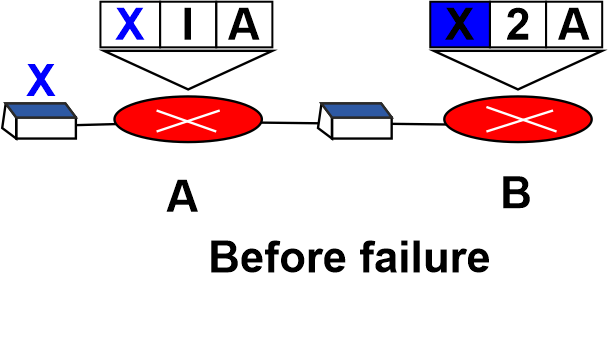
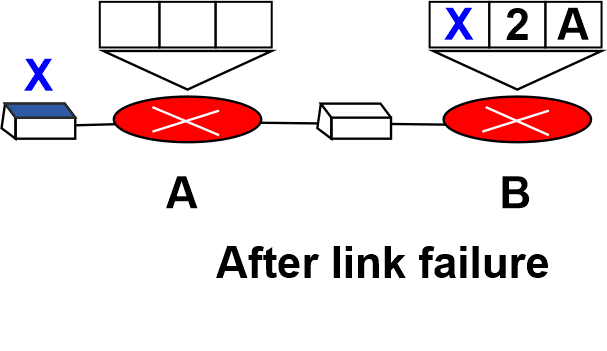
- A system with three nodes is depicted in the figure. Only the elements of the forwarding table required for our discussion have been displayed. Nodes A and B are first able to connect to node X. However, the connection between A and X abruptly breaks down. The table of Node A is altered. Everything will be good if A can quickly transmit its table to B. If B, instead of waiting for A to transmit its forwarding table, sends its forwarding table to A first, the system becomes unstable.
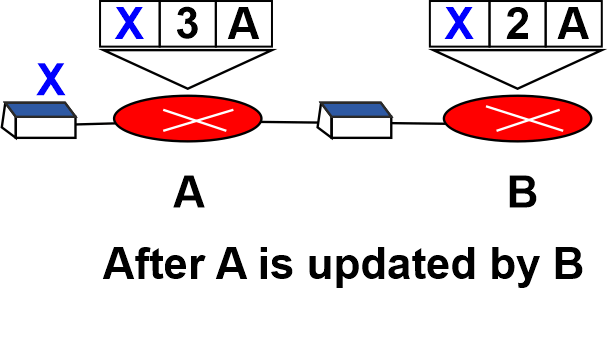
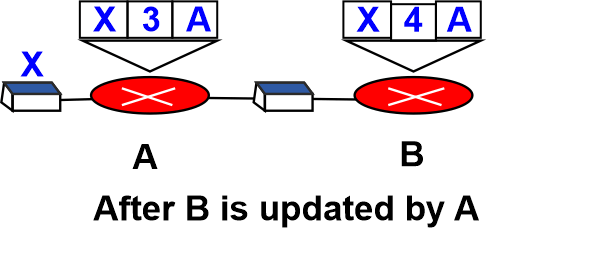
- When Node A receives the update, it instantly updates its forwarding table in the event that B has managed to connect to X. A has just updated B and sent it a fresh message. B has now updated its forwarding table as it believes that something has changed around A. Until it approaches infinity, the price of getting to X rises gradually. Both A and B are aware that X cannot be reached at this time. In contrast, the system is unstable at the present time.
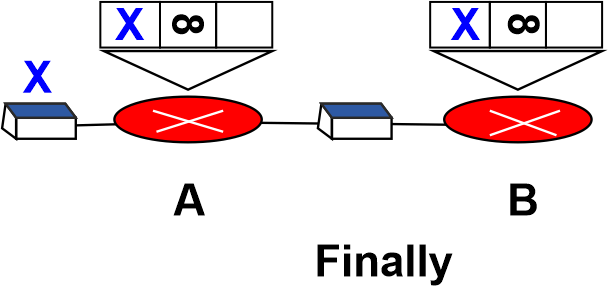
- Node A believes that node B is the path to X, while node B believes that node A is the way to X. When A gets a packet intended for X, the packet first travels to B before returning to A. Similar to this, if B receives a packet meant for X, it travels to A before returning to B. A two-node loop problem is caused by packets bouncing between A and B. There are a few remedies that have been suggested for this form of instability.
The following is the answer to the problem of counting to infinity:
- Split Horizon
The split horizon is a method for resolving instability. Each node in this technique delivers a portion of its table across each interface rather than flooding the table through all of them. If node B believes that the best way to go to X is through node A, then node B need not inform node A of this information because it has already been provided by node A (A already knows).
Confusion is brought on by receiving data from node A, altering it, then sending it back to node A. In our example, node B trims the end of its forwarding table before transmitting it to node A. In this instance, node A maintains a distance to X of infinity. Later, node B similarly makes corrections to its forwarding table when node A transmits it to it. After the initial update, the system is stable because both nodes A and B are aware that X cannot be reached. - Poison Reverse
The split-horizon approach has one disadvantage. If there is no news about a route after a certain amount of time, the corresponding protocol typically employs a timer and instructs the node to remove the route from its table. In the previous example, node A is unable to determine whether node B's decision to remove the route to X from its advertisement to node A is the result of the split-horizon technique (the information came from A) or the fact that B has not recently received any news concerning X.
In the poison reverse technique, B can still state the value for X, but if the information came from A, it can substitute infinite for the distance as a warning: " Do not utilise this value; you are the source of my knowledge regarding this route."


